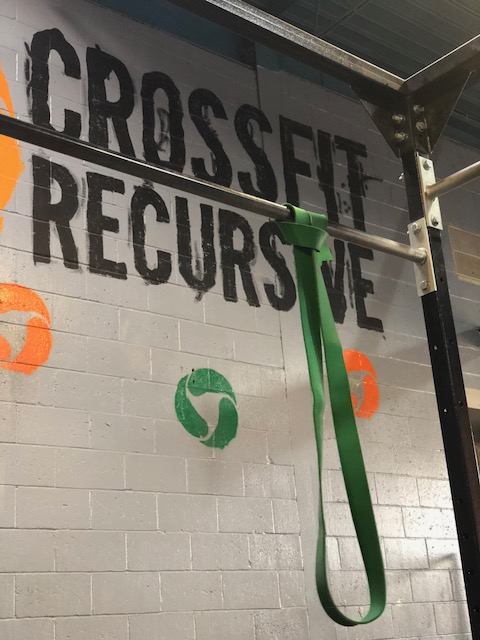I have been CrossFitting for many years (I just had to go look it up…since 2011 actually.) In that time I have been to a lot of different gyms. When I first started it was pretty standard to use bands for assistance with bodyweight movements like pull ups and ring dips.
As CrossFit became more mainstream the trend over the last few years has been to eliminate bands for assistance work and focus their use for resistance work.
If you don’t know me personally, I am a larger female athlete at 6′ tall. Bodyweight movements are never my favorite things and never my strength in a workout. I have used bands for a long time and never saw the results I wanted. I didn’t feel like I was any stronger or any closer to being able to do those pull ups or ring dips without a band in a workout.
I did some research. I signed up for the CrossFit Gymnastics Course (one of my all time favorite specialty courses.) I started taking private lessons from a gymnastics coach in town.
All of those resources told me the same thing. Bands are best for resistance, not assistance. If you walk into a gymnastics studio you will not find a single band anywhere. So, why aren’t bands working to help athletes get stronger for bodyweight movements. And if we aren’t going to use bands, how do we modify bodyweight movements?
Why Bands aren’t making you stronger.
When we are using bands for a pull up, we step into the band with a foot and most often the first thing the athlete does is cross their feet. Mistake #1 – we have just taken ourselves out of the good hollow body position.
Then, because we know we are using a band that is on our foot, the focus becomes using your legs and the tension on the band to get our chin over the bar. Mistake #2 – we have lost focus on using our upper body muscles to perform the movement.
Because of the nature of the band and it’s stretch reflex, we get the most help at the bottom when the band is stretched tightest and the least amount of help at the top. This prevents the athlete from needing to gain any strength at the bottom of the pull up – the first first inches which are often the hardest for people. Mistake #3 – we are getting too much help at the bottom of the pull up.
As we pull up using the band at our feet we catapult our chins over the bar without ever having to engage the right muscles at the right time. Mistake #4 – we aren’t using or training the right muscles for the pull up.
How do we modify bodyweight movements then?
If there is a barbell or a kettlebell in a workout and it’s too heavy, you just drop the weight. But obviously we can’t just take 20# of our body if we aren’t yet able to perform that bodyweight movement.
What we need to do is find a way to alleviate some bodyweight while maintaining the form and function of the movement so we can still develop the strength needed.
If the purpose of the pull up in the workout is to build strength, ring rows are a great start. You are using all of the same muscles, just at a different angle. You can work those lats in a horizontal pulling motion at first and then switch to vertical pulling. You can set up rings and put your feet on a box to help. You can also set up a barbell on some j-clips, strap the barbell down with some bands (see – we can use them for help!), and work on developing that vertical pull.
If the purpose of the pull up in the workout is power and fatigue (as in kipping), jumping pull ups may be a good modification, as long as done properly and in smaller amounts to avoid too much emphasis on the negative.
Now, bands may have a place in the gym. I am not saying you should never use them. They can be helpful in helping an athlete get the feel for a movement. I often use bands when athletes are first learning the butterfly kip. At that point though, the athlete is strong enough for strict pull ups and coordinated enough for regular kipping. The band is simply a tool to help at this point, but I wouldn’t use bands in a workout. There are more efficient ways to help an athlete build strength.

